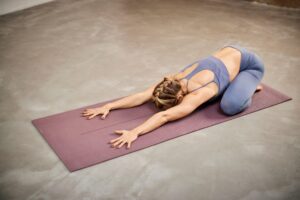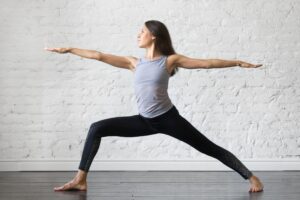Introduction
For centuries, yoga has been a widely embraced form of exercise, and its popularity has been surging in recent years – for good reason. Blending physical postures, breath control, and meditation, it’s a holistic practice that enhances well-being on all fronts – body and mind.
Several benefits accrue to one’s psychological well-being by practicing yoga, including stress reduction, mood enhancement, increased self-awareness, better sleep, and relief of depressive symptoms. Yoga promotes mindfulness and self-awareness, contributing to improved emotional resiliency and better management of psychological well-being issues. Overall, yoga is an excellent choice for individuals seeking to enhance their well-being and achieve greater control of their mental states.
Yoga postures combine bodily movements with focused breathing and mindfulness to promote psychological clarity, calmness, and total well-being. Clearing the mind and reducing stress and anxiety is essential for emotional well-being. This blog explores ten yoga postures that can support your mental health.
Find Your Inner Peace with the Downward-Facing Dog Yoga Pose
Adho Mukha Svanasana, commonly known as Downward-Facing Dog Pose, is a popular yoga pose that relieves stress and anxiety. To get into this pose, begin on all fours with your arms and feet shoulder-width apart and gradually lift your hips towards the ceiling, creating an inverted V-shape with your body.
This posture is highly beneficial in stretching and relaxing your shoulders, neck, and back muscles, which often become tight and tense due to stress and anxiety. By letting your muscles loosen up, your body can release the tension, eventually calming your mind. Make sure to add this pose to your yoga routine to feel a sense of peace and tranquillity.
To correctly perform the Downward-Facing Dog Pose with proper posture and technique, follow these simple steps:
- Begin in a quadrupedal position, with your shoulders above your wrists and hips above your knees. Spread your fingers apart and firmly press your palms into the mat. Next, tuck your toes under and straighten your legs and arms, forming an inverted V shape. Lengthen your spine and press your heels towards the floor while relaxing your neck and pulling your shoulder blades down. Engage your core muscles and take deep breaths while holding the pose. To exit, exhale and lower your knees back down to the mat. This posture enhances flexibility, balances hormones, and invigorates the body.
Childs Pose
Child’s Pose, known as Balasana in Sanskrit, can be an incredibly effective yoga posture to relieve physical tension while remaining simple to execute. This gentle stretch is ideal for soothing your back, shoulder, and neck muscles and promoting relaxation.
Proper posture and technique are key to mastering Child’s Pose. Follow these simple steps to get it right:
- To get into this pose, start on all fours with your wrists under your shoulders and knees hip-width apart. Take a deep breath, then exhale as you lower your hips toward your heels.
You can do this pose in various ways. Stretch your arms out in front of you with your palms on the ground, or position them next to your torso. Find the option that lets you do the exercise with good form and feels most comfortable.
Rest your forehead on a block or pillow for support if it doesn’t comfortably reach the ground. Keep your shoulders back and your neck in a relaxed position.
Hold the pose for several breaths, focusing on relaxing your back, hips, and shoulder muscles. Take a deep breath in, then lift your head and chest back up to the kneeling position to exit the pose. Remember to maintain proper form throughout.
Tree Pose
Vrikshasana, or Tree Pose in Sanskrit, offers much more than physical benefits. Standing on one leg with the other elevated requires unwavering focus and stability, which in turn, enhances mental clarity. Additionally, the pose works the feet, legs, and core muscles while providing a grounding sensation of stability and balance. This feeling of centeredness can prove valuable in sharpening your focus and concentration. Incorporating Tree Pose into your yoga practice can help improve your mind-body connection and offer mental and physical stability.
Follow these simple steps to achieve proper posture and method while performing the tree pose:
- To begin, stand in Tadasana (Mountain Pose), with your feet hip-width apart and arms at your sides. Shift your weight to your left foot and flex your right knee, placing your foot inside your left leg to assume the posture. Keep your pubic bone in contact with your heel. If you have trouble balancing with your foot on your inner thigh, your left calf or ankle may suffice.
Use your left leg to avoid pushing your right foot into your left thigh. Engage your core muscles, lengthen your spine, relax your shoulders, and maintain good posture. You may join your hands in front of your heart or raise them in prayer, palms facing each other. Take a few slow, deep breaths and hold the posture while focusing on maintaining your balance and stability.
To exit the pose, return to Tadasana and carefully lower your right foot to the ground.
Warrior II Pose
You can reap the benefits of a robust posture, enhanced psychological and emotional well-being, and increased bodily strength by practicing the Warrior II Pose in yoga. By regularly assuming this pose, you strengthen your inner resolve and confidence, which can boost your overall well-being.
To execute the Warrior II Pose correctly with proper posture and technique, follow these simple steps:
- Begin in Tadasana, or the Mountain Pose, with your feet apart and arms at your sides. Step back with your left foot while facing forward with your right, turning your left foot out at a 90-degree angle. Straighten your legs, plant your feet firmly, and engage your thighs to lift your kneecaps.
As you inhale, raise your arms to shoulder height, ensuring they are straight and parallel with your palms facing down. While exhaling, bend your right knee over your ankle, maintaining a perpendicular shin. Ensure your knee doesn’t extend over your ankle and keep your left leg straight and sturdy with pressure on the outer edge of your foot.
Turn your head to the side to view your right fingertips and hold the pose for a few deep breaths, centering on stability and strength. To return to Tadasana, straighten your right leg and lower your arms, then step your feet back together. Repeat the process on the opposite side.
By following these steps, you can perform Tadasana with ease and grace while improving your posture, balance, and strength.
Garland Pose
In today’s fast-paced world, stress has become a prevalent problem that affects physical, emotional, and mental well-being. One effective method to alleviate stress is Yoga’s Garland Pose, also known as Malasana, which eases pressure and promotes rest. This pose effectively reduces tension in the hips and lower back, two areas where stress accumulates.
For those aiming to master Garland Pose (Malasana), focus on posture and proper form by following these simple steps:
- Start by standing on your mat with your feet hip-width apart. To perform a deep squat, bend your knees and drop your hips towards the ground, taking deep breaths as you do. Ensure your feet are flat on the ground and planted firmly, adjusting their position for maximum comfort. To stretch your legs, gently use your elbows to push them apart while keeping your arms together at the center of your chest. Stay upright, extend your spine, and feel the stretch. Place your hands on the ground, or keep them at your heart’s center and extend your arms forward. Hold the pose, taking deep breaths and allowing your body to relax and release tension. Finally, bring your arms back to your heart’s center to complete the posture and straighten your legs to stand up.
Camel Pose
The Camel Pose, or Ustrasana, is a powerful yoga posture with significant physical and mental benefits. One of its important benefits is the ability to boost energy levels. The pose is aptly named after the shape of a camel’s hump, representing the lift in the chest that occurs during the posture. Here is a guide on executing the Camel Pose accurately, with correct alignment and technique.
- Let’s start this exercise by kneeling, with your knees hip-distance apart and feet flat on the ground. Ensure that your thighs are at a perfect 90-degree angle to the ground.
- To perform the exercise:
- – Place your hands on your lower back with your elbows close to your waist.
- – Inhale and focus on drawing your shoulder blades towards your spine and lifting your chest upward.
- – Slowly lean back, keeping your hips over your knees, and your thighs parallel to the ground. Only go back as far as is comfortable.
- – Maintain length in your neck and keep your gaze forward, avoiding letting your head sag backward, which can cause strain in your neck.
- – Keep this pose for a few deep breaths, feeling the stretch in your chest and the opening of your heart.
- – To return to a seated position, bring your hands to your lower back and lift your chest, then gently come back up.
- Enjoy the stretch and breathe deeply!
Seated Forward Fold Bend
Pasimottanasana, commonly called the Seated Forward Bend pose in yoga, is considered one of the best for calming the mind and easing anxiety. To perform this asana, sit on the floor with your legs extended in front of you and fold forward from your hips. As you bend, your hamstrings, lower back and calves stretch gently, promoting relaxation and release of tension throughout your body.
Learn the right alignment and method for executing Seated Ahead Bend through these helpful tips:
- Begin seated with your legs extended in front of you. Sit up tall and lengthen your spine.
- Inhale deeply, then exhale as you fold forward from the hips. Stretch your arms out to touch your feet or ankles. If needed, use a strap or cloth to reach your feet.
- Avoid curving your back or bending over by keeping a long, straight spine. You can use a prop to support your forward fold or bend your knees slightly if you feel your back starting to curve.
- As you fold, engage your core muscles to lower your back and protect your spine.
- Relax your shoulders and allow your head to hang heavy.
- Hold the pose for several deep breaths, releasing any tension as you exhale.
- To finish the pose, slowly roll up through your spine, carefully stacking each vertebra on top of one another.
Pigeon Pose
Pigeon Pose, or Eka Pada Rajakapotasana, is a restorative yoga posture that’s great for loosening tight hips and reducing tension in the lower back. Its benefits are particularly valuable for people who spend extended periods sitting down. Practicing this pose regularly can significantly enhance your hip flexibility and help you replenish your energy levels.
Here is how to do Pigeon Pose with the correct alignment:
- Begin on all fours, positioning your wrists under your shoulders and your knees below your hips. Slide your right knee forward, and place your shin at an angle with your knee pointing toward your right hand. While keeping your left thigh parallel to your mat, slide your left leg back with the top of your foot on the ground and your knee touching the floor. Ensure that your hips are level and aligned with the front of your mat. Use a block or folded blanket under your right hip for support if necessary.
Lengthen your spine, inhale deeply, and allow your entire body to relax while you exhale. Stay in this posture, or for a more profound stretch, stretch your arms forward and lower your chest towards the floor.
Repeat the steps on the opposite side after holding the posture for several long, deep breaths.
Savasana
Sasana, the ultimate resting pose in yoga, is essential to follow. Although it may seem like simply lying down, it is actually a powerful tool for restoring and meditating that can help in cultivating mindfulness and inner tranquility.
Here’s a guide on how to perform Savasana:
- Lie down on your back with your arms by your sides and legs straight. Ensure your body is aligned straight from head to toe.
Take a moment to allow your feet to relax and stretch upward. Close your eyes and breathe deeply, in through your nose and out through your mouth. As you exhale, feel your body unwinding and releasing any tension. Scan your body, consciously relaxing each muscle as you travel from the top of your head to the tips of your toes. Identify any tight, uncomfortable areas and patiently release them. By doing this, you’ll ease your muscles and rid yourself of any anxiety, giving you a refreshing sense of calm.Concentrate on your breath, allowing it to become slow and regular. Stay in this posture for a few minutes, allowing your body to relax and calm your mind.
Gradually bring your focus back to your body to exit the posture. Begin breathing more deeply and moving your fingers and toes. Get comfortable by taking a few deep breaths, rolling onto your side, and then rising slowly to a seated position.
Conclusion
Practicing yoga every day can significantly boost your psychological well-being. From reducing stress and anxiety, promoting tranquility, and increasing energy and self-confidence to inspiring mindfulness and improving focus. To maximize the benefits, it’s crucial to maintain proper posture and technique. These tips will help reduce the risk of injury and amplify the results of your practice.











